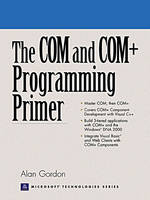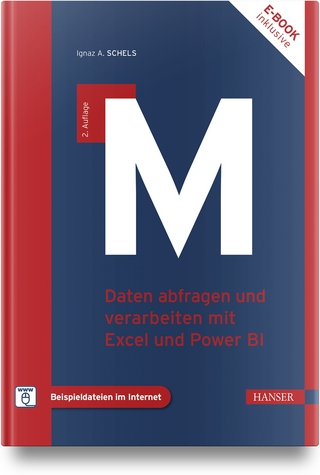
COM and COM+ Programming Primer, The
Addison Wesley (Verlag)
978-0-13-085032-4 (ISBN)
- Titel ist leider vergriffen;
keine Neuauflage - Artikel merken
PLEASE PROVIDE
COM and COM+ are the foundation of virtually every new technology Microsoft is developing, and COM+ is an essential feature of Microsoft's Win 32 platform (and, therefore, a cornerstone of Windows 2000). COM and COM+ have a reputation for being extremely difficult to learn -- but it doesn't have to be that way. COM and COM+ Programming Primerteachesbothtechnologies from scratch-- step-by-step, using on-target analogies, simple example programs, and an "inside-out" teaching method that makes sure readersreallyunderstand before introducing shortcuts such as Microsoft's wizrads.KEY TOPICS:Alan Gordon starts with crystal-clear definitions of every Microsoft technology related to COM, including ActiveX, OLE, DCOM, DNA, and COM+. Understand the fundamental classes, objects, and interfaces associated with COM. Next, build your first COM object, and simplify it using ATL 3.0 and Visual C++ Native COM support. In Section II, dig deeper into COM: create an out-of-process server; understand Automation; work with COM callbacks and connectable objects; master threading; and review the additional distributed development features Microsoft introduced with DCOM. Next, understand the key distributed technologies that set the stage for COM+: Windows DNA, the Microsoft Transaction Server, and MSMQ. Finally, in four practical, hands-on chapters, you'll start working with COM+ in the Windows 2000 environment: creating objects, working with threading, even building full-fledged n-tier applications.MARKET:For beginning-to-intermediate-level developers with some knowledge of C++ , Visual C++, and/or Visual Basic, but little or no prior knowledge of COM or COM+.
ALAN GORDON is a senior software developer at a startup company called FieldCentrix in Irvine, CA. He is also an instructor at the UCLA Extension School, where his hands-on teaching methods have won consistent praise.
(NOTE: Each chapter concludes with Summary.) I. LAYING THE FOUNDATION.
1. What's in a Name?
COM. DCOM. MTS. Windows DNA. COM+. ActiveX. OLE.
2. Classes, Objects, and Interfaces.
What is Object-Orientation? Classes. Objects. Interfaces.
3. Get on the Software Bus.
Software Bus Problems.
4. Building Your First COM Object.
The Simple Spell Checker. A Summary of the Steps. Creating a New DLL Project Using Visual C++. Creating a Custom Interface Using IDL. Declaring a C++ Class That Implements the COM Interface. Implementing the SpellChecker Interface. Creating a Class Object. Creating the Required DLL Entry-Points. Creating the Registration Functions. Creating a Client.
5. Making It Simple with ATL and Visual C++ COM Native Support.
A Quick Introduction to ATL. The Writer's Component. Creating an ATL Project Using the ATL/COM AppWizard. Adding the Document Checker COM Class Using the ATL Object Wizard. Implementing ISpellChecker. Implementing IgrammarChecker. Creating a Client with Visual C++'s Native COM Support.
II. DIGGING DEEPER.
6. Creating an Out-of-Process Server.
Marshaling. Instancing. Class Object Registration. Registering an Out-of-Process Server. Building an Out-of-Process Server. A Summary of the Steps.
7. Automation.
Defining Automation. Idispatch. Defining Idispatch Interfaces. Variants. Dual Interfaces. Building an Automation Server. A Summary of the Steps.
COM Callbacks and Connectable Objects.
Understand COM Callbacks/Events. Connectable Objects. Implementing Connection Points. The Connection Point Protocol. Your Multithreaded Stock Monitor Example.
9. COM Threading.
Definitions and Background. Multi-Threading and COM. Implement Objects That Will Run in Any STA. Implement Objects That Will Run in the Primary STA. Implement Objects That Will Run in the MTA. Implement Objects That Will Run in the TNA. Compare the Different Threading Models: An Apartment Study.
10. Distributed COM.
The Importance of DCOM. Location Transparency Revisited. Security. Example: Configuring a Server via DCOM.
III. COM+.
11. An Introduction to the COM+ Architecture.
Why Do You Need COM+? Application Architecture. The COM+ Solution. How It Works: The COM+ Architecture. Configure an Object to Use COM+.
12. An Introduction to the COM+ Services.
Fine-Grained Security. Transactions. Scalabilty. Synchronization. Queued Components. Load Balancing. Compensating Resource Managers.
13. Building a 3-Tiered Application Using COM+ and Windows DNA 2000.
What is the Windows DNA? The Windows DNA 2000. Creating Your First COM+ Application. The Publisher Example Program. Building the Publisher Example Application. Object Pooling. Deploying COM+ Application. Differences Between COM+ and MTS. Debugging with COM+.
14. Queued Components.
What are Queued Components? Why Do You Need Queued Components? Microsoft Message Queue. Installing and Using MSMQ. Using Queued Components in Your Example Program.
15. COM+ Events.
Why Do You Need COM+ Events? COM+ Events. Using Queued Components with Events. COM+ Events and Transactons. Filtering Events. Using COM+ Events in a Distributed Environment. Your COM+ Stock Monitoring Program.
Index.
| Erscheint lt. Verlag | 21.4.2000 |
|---|---|
| Zusatzinfo | Illustrations |
| Verlagsort | Boston |
| Sprache | englisch |
| Maße | 235 x 235 mm |
| Gewicht | 1210 g |
| Themenwelt | Informatik ► Betriebssysteme / Server ► Windows |
| Mathematik / Informatik ► Informatik ► Netzwerke | |
| Mathematik / Informatik ► Informatik ► Programmiersprachen / -werkzeuge | |
| ISBN-10 | 0-13-085032-2 / 0130850322 |
| ISBN-13 | 978-0-13-085032-4 / 9780130850324 |
| Zustand | Neuware |
| Haben Sie eine Frage zum Produkt? |
aus dem Bereich


